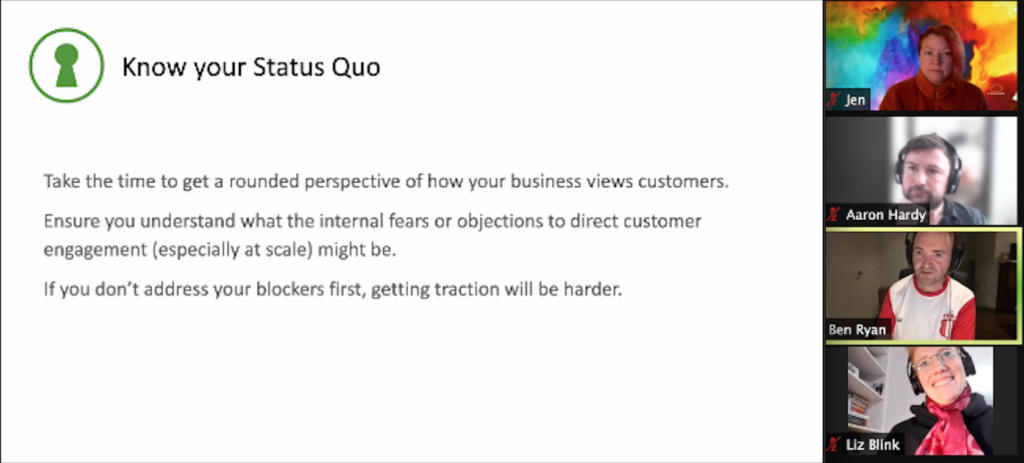More companies are realising that the path to success includes knowing their customers better. As they commence their journeys towards continuous discovery to deeply understand their customer and their problems, there can be some lofty expectations. However, the reality is often very different, and can be fragmented, chaotic and full of barriers.
In June, we caught up with Ben Ryan who shared 3 lessons from his experiences at FatSecret.
Lesson 1: Challenging the Status Quo
How well do we really know our customers? Just a little, ie. at a surface level? Perhaps it’s as little as reading the feedback or complaints that actually make their way to us. Or possibly even less than that.
Recognising this as a problem and the need for change is only the first step. However, making the case can be another story.
Resistance can coming in various forms:
- Sacred cows – firmly held beliefs that are rarely questioned and/or exempt from criticism or opposition, even in the face of contradictory evidence;
- Brittle foundations – legacy systems which are too hard to change;
- Sunk cost fallacy – ‘we’ve already invested so much in this direction/system/platform, so it’s too late to change now’;
- Or just being comfortable – changes require effort and moving towards the unknown.
Teresa Torres talks about having weekly conversations with your customers.
However, FatSecret was far from that. They had convoluted pathways for customers to make contact, and a small team (of 3 people) already inundated with 200-300 emails per week. This drove a fear of scaling, and not being able to handle additional volumes if the floodgates were opened. Furthermore, a dispersed customer base, with less than 1% within Australia, introduced additional geographical, cultural and linguistic challenges.
As an app, the other option for your customers is to leave public (1 star) reviews on the app store for others to read. Not a great alternative.
Even though there was no clear line to customers, they got scrappy and improvised. They also kicked off a longer process of a qualitative and quantitative research project with an external agency. Its brief was to gather insights, and begin co-designing the future vision. Once they started to build things that customers were vocalising as their pain points, retention started to improve, and there was an increase in active usage and engagement.

Lesson 2: Revisit old ideas with fresh eyes
There will always be some ideas that don’t work out. But it is also good practice to revisit those ideas later. What was wrong with those ideas, and what were the conditions the first time around? Are those conditions still in play, or has the environment changed? Do you have new lessons or understand things differently now? With a different perspective, you may find elements worth pursuing or that can be repurposed. And other times, they may turn out to still be bad ideas.
To try and place customer experience at the forefront of decisions, FatSecret introduced a discovery phase at the start of projects. Surely doing discovery about a business objective would help them identify customer needs earlier, to ensure they were solving customer problems?
Unfortunately not.
In reality, Project Discovery was unsuccessful as:
- Discovery didn’t begin until the project had been incepted around a business goal;
- Having a big deliverable at the start of the project, required time to do the customer discovery;
- There was high overhead (and difficulty) finding target users with the problems that aligned with the business goal;
- Discovery became a reflection of the customer experience, producing only a limited and blinkered view of the customer problems, and not going deep enough into the wider customer journey to understand the context of the problems.
Lesson 3: Continuous Improvement
Invest in the time for reflection.
Similar to re-evaluating past ideas, it can also be beneficial to circle back to past decisions and assumptions, and challenge your original thinking. Were the assumptions correct? Would the potential outcome be different from what you know now? Are you pursuing the best options, or are there better opportunities available?
Four years on, FatSecret has started moving towards Continuous Discovery to generate insights. Customers are interviewed on a regular basis, and then mapped to overarching archetypes, to understand their various drivers and how they will respond to different types of obstacles.
There’s still a long way to go, but FatSecret have progressively put distance between what used to be their status quo, and where they are now.
Resources and further reading
Some of the resources mentioned during this session (and a few bonus ones too):
- https://www.askable.com/ for customer research;
- Continuous Discovery Habits by Teresa Torres;
- Thoughts on Talking directly with customers from Rich Mironov;
- IDEO’s course on human centered design course;
- Working with User Research from the Product Anon Archives;
- What is Kumara
Thank you
Thank you to Ben Ryan (Head of Product at FatSecret) for sharing, our volunteers Gwen and Nosh, and to our generous host and Zoom sponsor, A Cloud Guru – they’re on a mission to teach the world to cloud.
